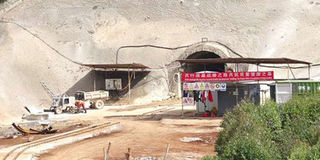Keep politics out of development projects

The Northern Collector Tunnel project in Makomboki, Murang'a. PHOTO | MARTIN MWAURA | NATION MEDIA GROUP
What you need to know:
- A project that promises to cure Nairobi’s perennial water shortage deserves support.
- However, there should be mechanisms to continually monitor and evaluate its impact.
The Northern Collector Tunnel project, also referred to as the Murang’a water tunnel, is a Vision 2030 project aimed at solving Nairobi’s water deficit. It is a project of the Athi Water Services Board and is funded by the World Bank.
According to board, the three-metre-wide tunnel will start on the fringes of the Aberdares in Murang’a county, some 60 kilometres from Nairobi, and will draw water from Gikigie, Irati, and Maragua rivers. These are some of the major tributaries of the River Tana.
The water collected will be channelled to Ndakaini Dam, then to the water treatment plant at Kigoro. It will then be transmitted to the city by a pipeline that has the capacity to deliver 140,000 cubic metres a day. This new supply will cover the deficit that currently stands at 125,000 cubic metres.
The project includes the construction of several community water projects in Murang’a and Kiambu counties to improve supplies to the host communities. The construction of the tunnel is going on, while some community water projects have been completed.
The multi-billion shilling project has been in the headlines in the past few days because of claims by opposition leader Raila Odinga that the tunnel would have a devastating impact on the environment. Mr Odinga said the project would turn the Tana basin into a desert in five years, that the tunnel is being constructed secretly, and that the communities in the two counties have not been consulted.
However, Murang’a and Kiambu leaders insist that all their questions had been satisfactorily answered and that they support the project.
ARE OPERATIONAL
The Murang’a Bulk and Mataara and Komothai water projects are operational, while the Gatanga, Murang’a, and Kiambu ones are near completion. Several other projects are in various stages of development.
Questions have been raised why Mr Odinga is criticising the project that he is reported to have launched when he was prime minister and whether he was aware of the environmental effects at the time.
These developments have, unsurprisingly, alarmed the communities along the path of the project – from the Seven Forks dams, which generate the bulk of electricity in Kenya, and the farming and pastoralist communities all the way to the Indian Ocean.
The Murang’a tunnel project will work along the principles of the Ndakaini Dam, which supplies 430,000 cubic metres of water a day to Nairobi. Other than reducing the severity of flooding of the River Thika, the dam has neither affected the flow of the river nor compromised the operations of the Masinga Dam.
A project that promises to cure Nairobi’s perennial water shortages deserves support. However, there should be mechanisms to continually monitor and evaluate the impact of the project. That is the work of the Independent Steering Committee. Mr Odinga’s claims raise legitimate questions that need to be answered openly and truthfully by the committee, not politicians.
Let us keep politics out of our development projects.
Andrew Maina is a businessman based in Thika and an author.




